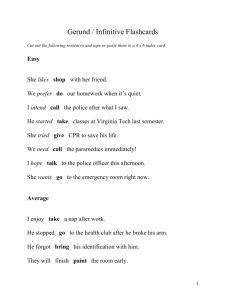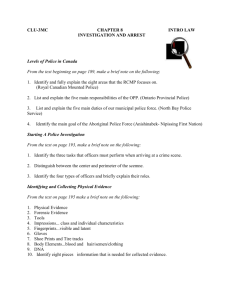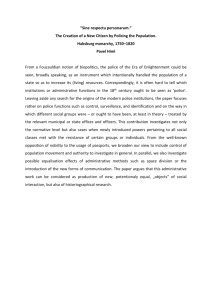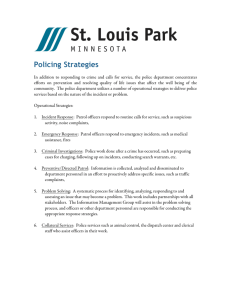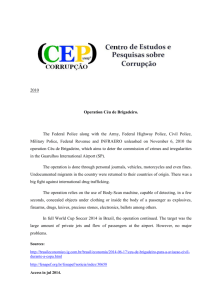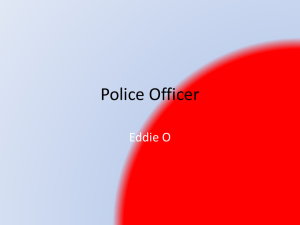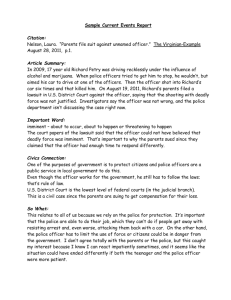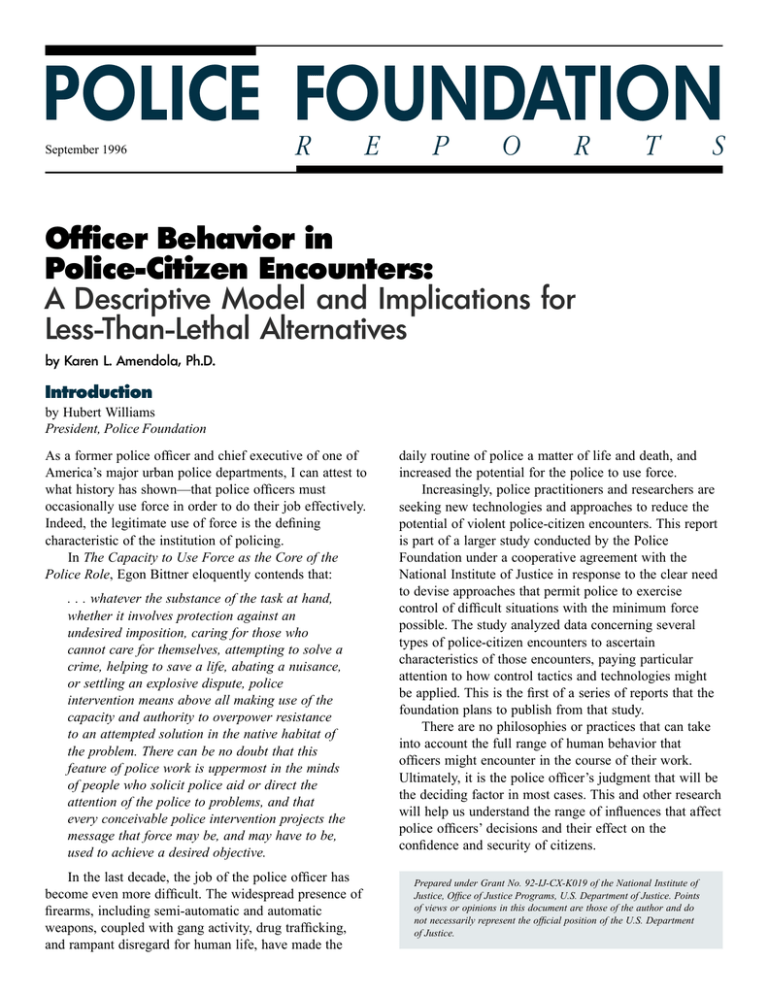
POLICE FOUNDATION
September 1996
R
E
P
O
R
T
S
Officer Behavior in
Police-Citizen Encounters:
A Descriptive Model and Implications for
Less-Than-Lethal Alternatives
by Karen L. Amendola, Ph.D.
Introduction
by Hubert Williams
President, Police Foundation
As a former police officer and chief executive of one of
America’s major urban police departments, I can attest to
what history has shown—that police officers must
occasionally use force in order to do their job effectively.
Indeed, the legitimate use of force is the defining
characteristic of the institution of policing.
In The Capacity to Use Force as the Core of the
Police Role, Egon Bittner eloquently contends that:
. . . whatever the substance of the task at hand,
whether it involves protection against an
undesired imposition, caring for those who
cannot care for themselves, attempting to solve a
crime, helping to save a life, abating a nuisance,
or settling an explosive dispute, police
intervention means above all making use of the
capacity and authority to overpower resistance
to an attempted solution in the native habitat of
the problem. There can be no doubt that this
feature of police work is uppermost in the minds
of people who solicit police aid or direct the
attention of the police to problems, and that
every conceivable police intervention projects the
message that force may be, and may have to be,
used to achieve a desired objective.
In the last decade, the job of the police officer has
become even more difficult. The widespread presence of
firearms, including semi-automatic and automatic
weapons, coupled with gang activity, drug trafficking,
and rampant disregard for human life, have made the
daily routine of police a matter of life and death, and
increased the potential for the police to use force.
Increasingly, police practitioners and researchers are
seeking new technologies and approaches to reduce the
potential of violent police-citizen encounters. This report
is part of a larger study conducted by the Police
Foundation under a cooperative agreement with the
National Institute of Justice in response to the clear need
to devise approaches that permit police to exercise
control of difficult situations with the minimum force
possible. The study analyzed data concerning several
types of police-citizen encounters to ascertain
characteristics of those encounters, paying particular
attention to how control tactics and technologies might
be applied. This is the first of a series of reports that the
foundation plans to publish from that study.
There are no philosophies or practices that can take
into account the full range of human behavior that
officers might encounter in the course of their work.
Ultimately, it is the police officer’s judgment that will be
the deciding factor in most cases. This and other research
will help us understand the range of influences that affect
police officers’ decisions and their effect on the
confidence and security of citizens.
Prepared under Grant No. 92-IJ-CX-K019 of the National Institute of
Justice, Office of Justice Programs, U.S. Department of Justice. Points
of views or opinions in this document are those of the author and do
not necessarily represent the official position of the U.S. Department
of Justice.
A descriptive model
of police-citizen
encounters and the
role of the police
officer in them is
presented in this
report. This model
is built on the
understanding that
in determining
influences on officer
behavior, it is more
important to focus
on risk factors
present in all these
encounters rather
than simply on the
type of situation.
2
T
he mandate to use force,
within the confines of the
law, is the defining feature of
the role of police in society. The use
of excessive force, or the allegation
of use, can threaten not only the
legitimacy of the police but of
government itself. Clearly, there is a
need to devise approaches involving
technologies and tactics that permit
the police to control difficult
situations with the minimum force
possible.
The National Institute of Justice
has held conferences of practitioners,
scholars, and manufacturers of
control technologies to discuss their
needs and perspectives. From those
conferences has come a consensus of
opinion that there are certain
scenarios in which the application of
control technologies appears
particularly fruitful. The scenarios
identified include “search warrants/
raids, domestic disturbances,
barricade/tactical assaults, and those
involving fleeing felons/patrol
applications.” However, little is
known about the frequency with
which such situations occur, their
characteristics, or the points at which
the police might be able to apply
particular tactics or technologies in
order to reduce the level of force
necessary to gain control of matters.
A descriptive model of policecitizen encounters and the role of the
police officer in them is presented in
this report. This model is built on the
understanding that in determining
influences on officer behavior, it is
more important to focus on risk
factors present in all these encounters
rather than simply on the type of
situation.
The decision by a police officer
to use lethal or less-than-lethal force
in encounters with citizens is an
issue of grave concern to police
agencies, officers, and the
community. Virtually all policecitizen encounters are dynamic
situations influenced by a range of
factors. There is a need for a
comprehensive, descriptive model to
help understand the larger factors
(dimensions) and specific variables
that affect the need or likelihood of
an officer using force. Such a model
could be applied across a variety of
situations, and could illustrate the
links between the various dimensions
of these situations.
While some (Binder and Scharf
1980; Scharf and Binder 1983; Toch
1985; Hayden 1981; Reiss 1980)
have proposed various models or
frameworks for understanding
police-citizen encounters and the use
of force, none of these fully depict
the range of situational dynamics in
police decision making. However,
the descriptive model outlined here
(Amendola 1995, see Figure 1),
captures these situational dimensions
within a broader framework.
Model of Officer Use of
Control Tactics and
Technologies
As this model shows, an officer’s
behavior is the culmination of a
variety of influences and others’
actions. Although there have been
extensive one-variable and some
two-variable studies published on
characteristics associated with use of
force, this is the first theoretical
framework comprehensive enough to
unify previous research.
In providing the Model of
Officer Use of Control Tactics and
Technologies in Police-Citizen
Encounters, it is hoped that
researchers will be able not only to
tie into a broader theoretical
framework but also to conduct
comprehensive, multi-variable
studies designed to more thoroughly
understand the multiple influences on
officer use of force.
The following report will detail
the components of the model.
Subsequent reports will discuss these
components within specific
Figure 1
Model of Officer Use of Control Tactics and
Technologies in Police-Citizen Encounters
➤ Situational Characteristics:
➤
Emotions of Officer
➤
Behaviors of Parties
(demeanor)
➤
➤
• Physical environment
• Presence of weapons
➤
• Injuries of parties
• Reasoning ability of parties
• Presence of officers
➤
Antecedent
Events
➤
Stable Traits
of Parties
Outcomes:
• Vehicular accidents
• Officer injury
• Offender injury
• Bystander injury
➤ • Victim injury
• Others’ reactions
• Media publicity
• Community reactions
• Personal coping of dollars
• Regrets of officers
➤
➤
Options Available:
➤ Goal
Selected Course
➤ • Technologies/tools ➤ of Action
• Tactics (via training)
➤
➤
➤
Officer Assessment
Expectations
➤ Planning ➤
of Situation
of Situations
➤
➤
➤
Situational
Information
Officer
➤ Behavior
➤
Officer
Characteristics
• Experience
• Demographics
Constraints & Facilitative Factors:
• Law
• Departmental policy
• Capacity
• Community
• Complaints
• Ethics/morals
• Norms
• Support
Copyright 1995 Police Foundation
situational domains, including highrisk search warrant issuances,
domestic disturbances, hostage and
barricaded persons incidents, and
felony suspects fleeing from police,
both in vehicles and on foot.
As part of this model, it is
important to consider antecedent
events, officer characteristics, citizen
characteristics, situational
characteristics, the range of options,
and the associated constraints upon
using any particular tool, technology,
tactic, or behavior as an intervention.
Antecedent Events
The precursors to any particular
encounter between the police and
citizens may directly influence any
number of situational characteristics.
A hostage situation begins with some
antecedent event; for example, the
break-up of an intimate relationship,
or a botched robbery attempt, which,
in turn, may define the boundaries of
the situation at hand.
Stable Traits of Parties
The characteristics of all parties
involved (offenders, suspects,
victims, witnesses, etc.) in the
situation can also play a significant
role in the situation. For example,
whether or not the parties are known
to one another, the nature of the
existing relationship(s), the
psychological profiles of individuals,
and demographic characteristics all
As this model
shows, an officer’s
behavior is the
culmination of a
variety of influences
and others’ actions.
3
may help define the situation being
faced. The Federal Bureau of
Investigation has long realized the
benefits of understanding the profiles
of criminal offenders. This is
particularly useful for hostage
negotiation (Reiser 1982).
Situational Information
Before arriving on the scene, an
officer has either been dispatched or
flagged down to respond to an
apparent problem. Pre-arrival
information, such as type of event,
which an officer receives
secondhand, can certainly affect his
or her other expectations of the
situation, which in turn may affect
any pre-intervention planning that he
or she does. Officers may also come
upon situations in progress and have
no more information than what they
see.
Officer Characteristics
Just as individual characteristics
of citizens can affect the situation
directly or indirectly, so too can the
characteristics of officers. For
example, the level of personal or
professional experience of an officer
may affect his or her expectations of
the situation, planning, assessment of
the situation, and ability to select or
carry out an appropriate action.
Officer Expectations of the
Situation. The social psychological
literature shows that one’s
preconceived notions or expectations
of an event can affect what actually
happens, in that some events can be
somewhat self-fulfilling (see, for
example, Snyder, Tanke, and
Berscheid 1977; Kelley and Stahalski
1970). This makes it important to
understand the expectations an
officer may have before arriving on
scene. Officers may have unique
interpretations of what to expect on
scene based on whatever information
they have already received. An
4
officer’s own characteristics (e.g.,
attitudes, beliefs, previous
knowledge, or experience) may bear
upon the processing of that
information, further influencing
planning or on-site assessment.
Planning. Although we often
conceive of police response as a
rather immediate action, the time
between dispatch and arrival is
critical for officer planning and
decision making. Should any specific
plans be made, they might interfere
with an officer’s ability to make an
adequate situational assessment and
select an appropriate response if they
are based on either inadequate
information or its misinterpretation.
Situational Characteristics
There are a number of visible
situational characteristics that may
influence how an officer assesses the
encounter. For example, the physical
environment in which he or she is
operating may be constrained (e.g.,
barricades, darkness, ability to gain
access). The presence and types of
weapons certainly will affect how an
officer evaluates the situation and
responds to it. If any of the parties
on scene appear injured, this adds
urgency to an officer’s assessment
and response.
Literature has been published
regarding the emotional states,
intoxication or drug abuse, and
mental illness of individuals in
police-citizen encounters. These are
not usually considered to be similar,
but all these limit the reasoning
ability of the parties encountered on
scene. The presence of other officers
on the scene also can influence how
an officer perceives his or her role
and change the dynamics of the
situation. Connors and Nugent
(1990) indicate that awareness of
vicious pets on the scene will also
have a bearing on police operations
or decision making.
Officer Assessment
of Situation
Accurate assessment of the
situation is essential to selection of
an appropriate response. The way in
which an officer processes situational
information is key in determining
what course of action he or she
selects, reflecting how he or she
perceives what options are available,
assesses the danger to himself,
herself, or others, and his or her
corresponding emotions.
Officer Emotions. Although the
stereotypical officer is without
emotion, in fact officer emotions
affect perception of the situation and
ultimately the officer’s goal in
handling the incident. There is a
dearth of research on the emotions of
officers before, during, and after
encounters with citizens.
Goal. The officer’s goal in the
encounter is the outcome he or she
desires. Once an officer has assessed
the situation, his or her goal serves
as a guide in the search for
behavioral, tactical, or technological
options for handling the incident.
Options Available
There are a range of tools,
technologies, tactics, and behavioral
alternatives available to an officer in
dealing with any particular situation.
A number of technologies or tools
may be available to the officer as a
result of standard issue equipment or
special equipment selected based on
situational expectations (e.g., tactical
assault weapons, bullet-proof vests).
A number of tactical strategies
learned through training or
experience may also be possibilities.
To handle a given situation, an
officer may also choose behavioral
options (e.g., verbal commands,
physical restraint) by themselves or
in conjunction with technologies,
tools, or tactics.
Constraints and
Facilitative Factors
Certain intervention options
available to an officer may appear
more favorable based on factors
facilitating the choice. These may
include expected support for
behaving in a specific manner or the
requirements of standard operating
procedures. Other alternatives may
be less attractive due to factors like
departmental policies or laws. A
variety of issues can constrain or
facilitate the choice of any particular
option that an officer has available.
These are outlined below.
Law. Police officers know that legal
interpretations are often based on the
dynamics of a situation, some of
which are statutorily cut and dried,
while others have much fuzzier
borders. For example, there are many
legal constraints governing the
lawful search of a vehicle. Given the
increasingly litigious nature of
police-citizen encounters, officers
must consider the legalities and
political ramifications of any selected
action and make decisions
accordingly, often in a split second.
Laws can also facilitate officer
actions in that they specify actions
that must be taken.
Departmental Policy. Standard
operating procedures and general
orders in departments are regularly
updated. Officers are obligated to
keep abreast of changes in these
policies and change their behavioral
repertoire accordingly. According to
O’Lear (1993):
There has been a strong shift
to enforcing standards in
nonlethal force options.
Florida has published lesson
plans of approved techniques
that are acceptable within
guidelines. If a police officer
does not use those
techniques, he may stand
alone in court.
Policies that mandate certain
actions under prescribed conditions
facilitate the choice of a course of
action. But when policies change,
standard procedures that have
become ingrained often necessitate
the retraining of officers, but
retraining is often hampered by
limited time and resources. Hence,
an officer’s job requirements and
responsibilities are not static, making
split-second judgments about
appropriate actions difficult.
Capacity. Although selection and
training systems in policing are often
designed to facilitate standardization,
individuals have unique differences
that may prevent an officer from
making an optimal response. For
example, physical capacities vary
significantly among individuals,
despite certain minimum standards in
departments. Intellectual and
reasoning capacities also vary.
Capacity can also be limited by
systemic factors such as fatigue (due
to shift schedule, time of day, etc.),
physical exertion, and a host of
organizational factors (e.g., one’s
assigned partner, the location in
which one is working, and the
resources to provide specific
technologies, tools, or training to
officers).
Given the
increasingly
litigious nature of
police-citizen
encounters, officers
must consider the
legalities and
political
ramifications of any
selected action and
make decisions
accordingly, often
in a split second.
Community. As the philosophy of
community policing continues to
take hold in police agencies,
increased awareness of community
perceptions can affect what options
an officer might select. The
anticipated community reaction to a
particular course of action may keep
an officer from choosing it or give
the officer greater confidence in
pursuing it.
Complaints. Citizen or departmental
complaints filed against an individual
officer may limit his or her
willingness to select a particular
course of action out of fear of
5
Perhaps one of the
most critical
considerations for
an officer in
determining which
behavior to select
is his or her
perception of
whether or not the
behavior may be
questioned and
who, if anyone,
will support it.
repercussions. This could lead to an
inappropriate choice or even
negligence in carrying out one’s
duties. Complaints filed against the
agency may have a similar impact.
For example, if there have been
growing public outcries regarding
racism on the part of an officer, this
may deter an officer from certain
means of dealing with perpetrators or
victims of particular races.
Ethics/Morals. Although many
police agencies have a formal or
informal code of ethical conduct,
individual officers may have ethics
or morals inconsistent with the code.
Further, some officers use their own,
higher order (or sometimes lower
order) morals to define how they will
behave. An officer may feel either
constrained or facilitated to act based
on his or her individual moral code,
the departmental code, or the broader
law enforcement code.
Norms. In addition to prescribed
responsibilities, policies, and
procedures, every organization has
its own unwritten set of rules for
behavior. Undoubtedly, there are subcultural norms that prescribe
acceptable behavior at yet another
level within organizations (see Alpert
and Dunham 1992); e.g., those of
detectives or of patrol officers. Many
of these norms may be inconsistent
with overall organizational or
professional norms and may
constrain or facilitate certain
behaviors.
Support. Perhaps one of the most
critical considerations for an officer
in determining which behavior to
select is his or her perception of
whether or not the behavior may be
questioned and who, if anyone, will
support it. If an officer perceives that
he or she has support and can justify
a particular action, that action will be
more likely to be taken.
6
Behaviors of Parties
Obviously an officer does not act
independently of the other citizens in
an encounter. The behaviors of
others can affect the situation,
outcomes, officer emotions, or officer
behaviors. The greater the number of
individuals involved in a situation,
often the harder it is to determine
what is happening, the perceived
threat to the officer(s) and others,
and the appropriate response(s).
Selected Course of Action. It should
be clear that there are a multitude of
influences on what an officer
ultimately does in any encounter.
The actions selected by the officer,
though often instantaneous or
reactive in nature, may depend upon
a thorough and appropriate
assessment of the situation and all of
its dynamics, the actors and the
available options, his or her capacity,
and other constraints or facilitative
factors.
Officer Behavior. The actions taken
by the officer can directly affect the
immediate situation, the lives of
individuals including himself or
herself, the victims, perpetrators or
suspects, innocent bystanders, and
witnesses. This may happen either
directly during the encounter or
through the activities or situations
that result from the encounter. The
actions can also influence subsequent
departmental policies, community
perceptions, and the officer’s career.
This all adds up to a responsibility
that sometimes seems overwhelming
to an officer and may add pressure to
an already volatile encounter.
Situational Outcomes
An encounter can produce
immediate or long-term effects on
people, such as injuries, property
damage, psychological trauma,
media attention, community
reactions, and even officers’
difficulty coping with the aftermath.
In some situations like hostage and/
or barricaded persons events, it is
important for all primary and
secondary negotiators to go through
critical incident stress debriefing
(Rivas 1996; Garrison 1996).
Conclusion
The model described in this
report can be used as a framework
for organizing findings from existing
literature and interpreting their
meaning. The Police Foundation has
also collected and analyzed new data
in the following areas: high-risk
search warrant issuances, domestic
disturbances, hostage and barricaded
persons incidents, and felony
suspects fleeing either on foot or in
vehicles.
Although hostage and barricaded
persons situations have distinct
definitions, many agencies do not
distinguish between these two
scenarios in collecting and
categorizing data because both
require the use of trained negotiators.
Many departments classify a whole
range of situations as hostage taking
or barricaded persons incidents, even
though many actually are suicides or
domestic disturbances (Rogan,
Hammer, and Van Zandt 1994).
Subsequent reports covering
these situational or other influences
on officer behavior will contain
information on several key incident
types. Data about hostage and
barricaded person events, domestic
disturbances, felony suspects fleeing
in vehicles or on foot, and high risk
search warrant issuances will be
described and interpreted according
to the model presented in this report.
Hopefully, researchers and
practitioners can use this model to
enhance their understanding of the
range of influences complicating a
police officer’s job, particularly in
dynamic situations such as those
described in this report.
References
Hayeslip, D. W., and Preszler, Alan
(1993). “NIJ Initiative on
Less-Than-Lethal Weapons.”
National Institute of Justice,
Washington, D.C., p. 3.
Alpert, G. P., and Dunham, R. G.
(1992). “Police Socialization
and Police Subculture.” In
Policing Urban America (2nd
ed.). Prospect Heights, IL:
Waveland Press, Inc.
Amendola, K. L. (1995). “Model of
Officer Use of Control Tactics
and Technologies in PoliceCitizen Encounters.”
Washington, D.C.: Police
Foundation.
Binder, A. and Scharf, P. (1980). The
Violent Police-Citizen
Encounter. Annals of the
American Academy of
Political and Social Sciences.
Connors, E. F., and Nugent, H.
(1990). Street Level Narcotics
Enforcement. Alexandria, VA:
Institute for Law and Justice,
Inc.
Garrison, W. (1996). “Innovations in
Hostage Rescue.” Presentation
at the Annual Conference of
the Council of Police
Psychological Services.
Pigeon Key, FL.
Hayden, G. A. (1981). “Police
Discretion in the Use of
Deadly Force: An Empirical
Study of Information Usage in
Deadly Force Decision
Making.” Journal of Police
Science and Administration
9:102–107.
Kelley, H. H., and Stahelski, A. J.
(1970). “The Social
Interaction Basis of
Cooperators’ and Competitors’
Beliefs About Others.”
Journal of Personality and
Social Psychology, 16:66–91.
O’Lear, J. K. (1993). “Defensive
Tactics as Communication.”
Law and Order, September
1993, pp. 131–135.
Reiser, M. (1982). “Crime-Specific
Psychological Consultation.”
The Police Chief, March 1982,
pp. 53–56.
Reiss, A. J. (1980). “Controlling
Police Use of Deadly Force.”
Annals of the American
Academy of Political and
Social Science, 452:122–134.
Rivas, R. B. (1996). “Critical
Incident Stress Management:
The Florida Team.”
Presentation at the Annual
Conference of Council of
Police Psychological Services,
Pigeon Key, FL.
Rogan, R. G., Hammer, M. R., and
Van Zandt, C. R. (1994).
“Profiling Crisis Negotiation
Teams.” The Police Chief,
November 1994, pp. 14–18.
Scharf, P., and Binder, A. (1983).
The Badge and the Bullet:
Police Use of Deadly Force.
New York: Praeger.
Snyder, M, Tanke, E. D., and
Berscheid, E. (1977). “Social
Perception and Interpersonal
Behavior: On the Selffulfilling Nature of Social
Stereotypes.” Journal of
Personality and Social
Psychology, 35:656–666.
Toch, H. (1985). “The Catalytic
Situation in the Violence
Equation.” Journal of Applied
Social Psychology, 15(2):
105–123.
I would like to thank Harriet
Mack, MSW, for assisting with the
formulation of the model in its
earlier form.
7
September 1996
© Police Foundation. All rights reserved.
8

